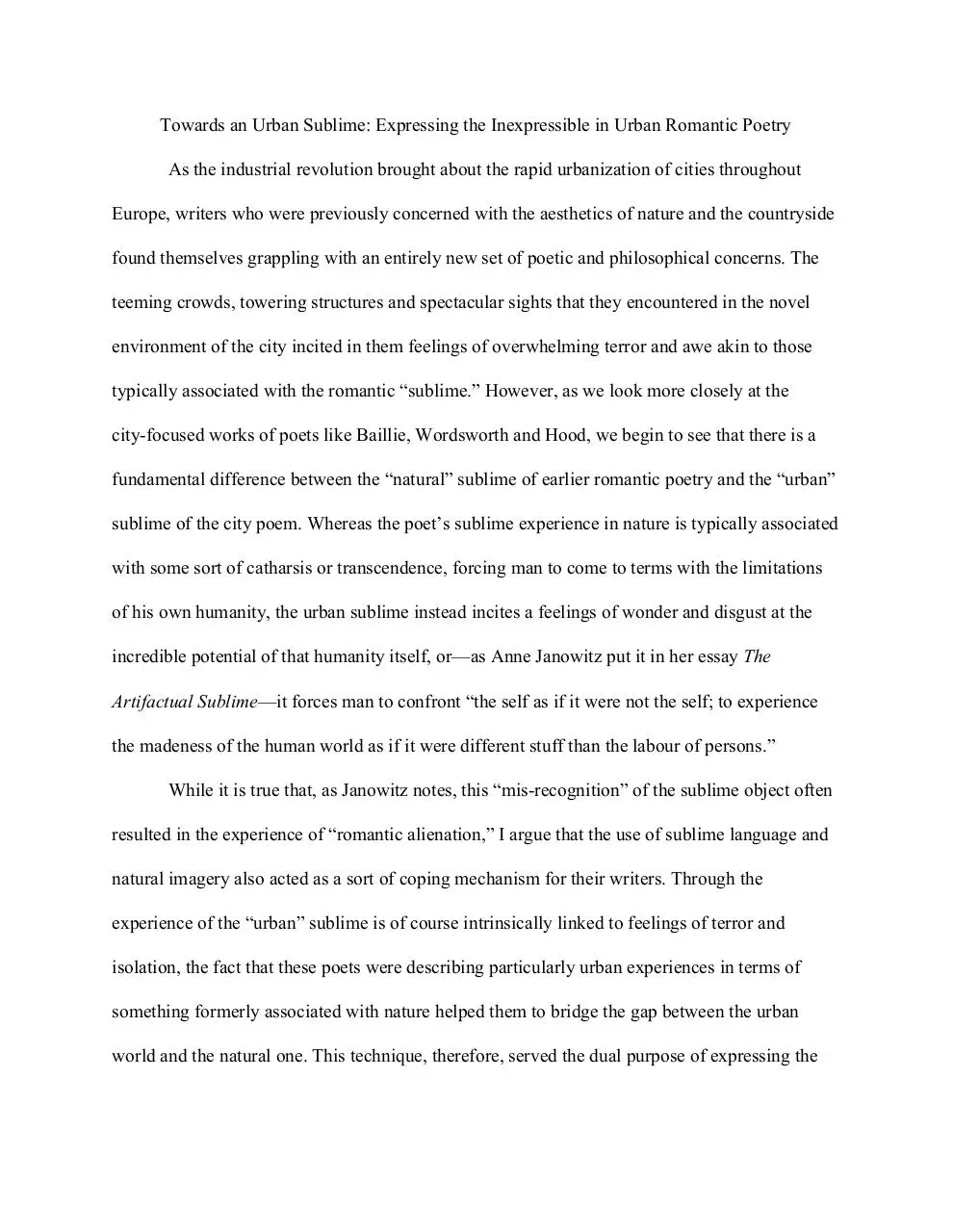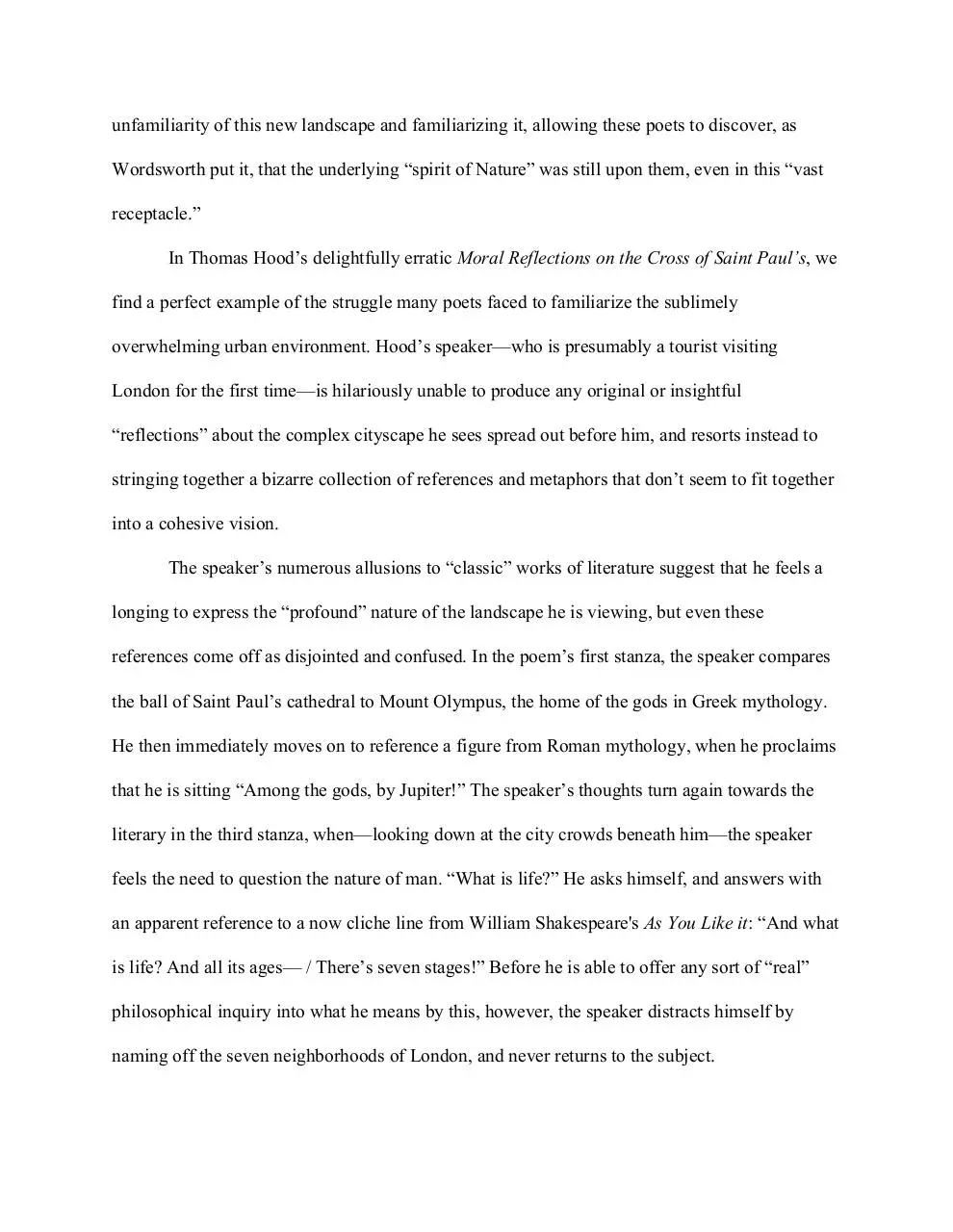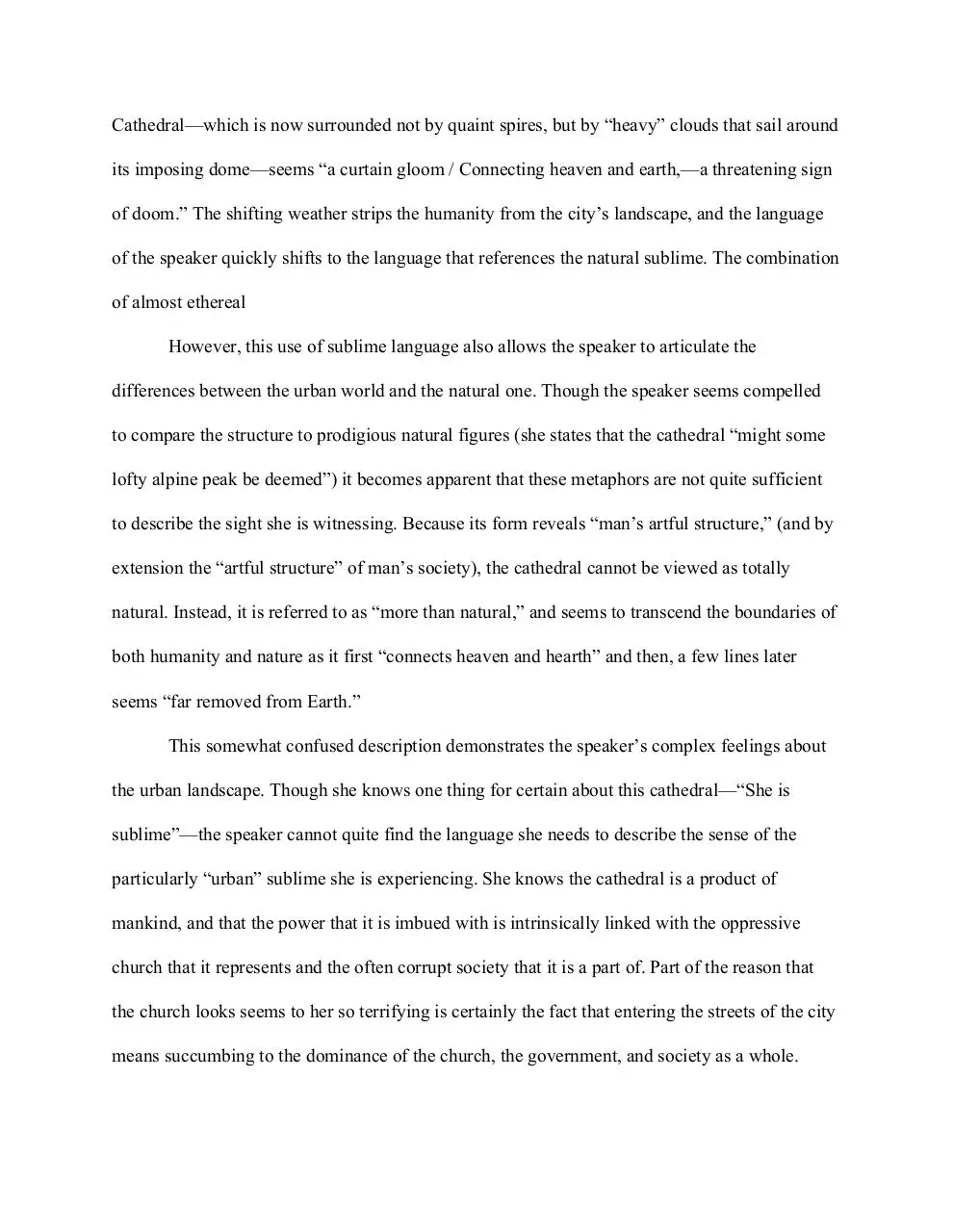thesublimecity (PDF)
File information
This PDF 1.5 document has been generated by / Skia/PDF m52, and has been sent on pdf-archive.com on 20/04/2016 at 08:47, from IP address 107.184.x.x.
The current document download page has been viewed 845 times.
File size: 168.4 KB (8 pages).
Privacy: public file





File preview
Towards an Urban Sublime: Expressing the Inexpressible in Urban Romantic Poetry
As the industrial revolution brought about the rapid urbanization of cities throughout
Europe, writers who were previously concerned with the aesthetics of nature and the countryside
found themselves grappling with an entirely new set of poetic and philosophical concerns. The
teeming crowds, towering structures and spectacular sights that they encountered in the novel
environment of the city incited in them feelings of overwhelming terror and awe akin to those
typically associated with the romantic “sublime.” However, as we look more closely at the
cityfocused works of poets like Baillie, Wordsworth and Hood, we begin to see that there is a
fundamental difference between the “natural” sublime of earlier romantic poetry and the “urban”
sublime of the city poem. Whereas the poet’s sublime experience in nature is typically associated
with some sort of catharsis or transcendence, forcing man to come to terms with the limitations
of his own humanity, the urban sublime instead incites a feelings of wonder and disgust at the
incredible potential of that humanity itself, or—as Anne Janowitz put it in her essay
The
Artifactual Sublime
—it forces man to confront “the self as if it were not the self; to experience
the madeness of the human world as if it were different stuff than the labour of persons.”
While it is true that, as Janowitz notes, this “misrecognition” of the sublime object often
resulted in the experience of “romantic alienation,” I argue that the use of sublime language and
natural imagery also acted as a sort of coping mechanism for their writers. Through the
experience of the “urban” sublime is of course intrinsically linked to feelings of terror and
isolation, the fact that these poets were describing particularly urban experiences in terms of
something formerly associated with nature helped them to bridge the gap between the urban
world and the natural one. This technique, therefore, served the dual purpose of expressing the
unfamiliarity of this new landscape and familiarizing it, allowing these poets to discover, as
Wordsworth put it, that the underlying “spirit of Nature” was still upon them, even in this “vast
receptacle.”
In Thomas Hood’s delightfully erratic
Moral Reflections on the Cross of Saint Paul’s
, we
find a perfect example of the struggle many poets faced to familiarize the sublimely
overwhelming urban environment. Hood’s speaker—who is presumably a tourist visiting
London for the first time—is hilariously unable to produce any original or insightful
“reflections” about the complex cityscape he sees spread out before him, and resorts instead to
stringing together a bizarre collection of references and metaphors that don’t seem to fit together
into a cohesive vision.
The speaker’s numerous allusions to “classic” works of literature suggest that he feels a
longing to express the “profound” nature of the landscape he is viewing, but even these
references come off as disjointed and confused. In the poem’s first stanza, the speaker compares
the ball of Saint Paul’s cathedral to Mount Olympus, the home of the gods in Greek mythology.
He then immediately moves on to reference a figure from Roman mythology, when he proclaims
that he is sitting “Among the gods, by Jupiter!” The speaker’s thoughts turn again towards the
literary in the third stanza, when—looking down at the city crowds beneath him—the speaker
feels the need to question the nature of man. “What is life?” He asks himself, and answers with
an apparent reference to a now cliche line from William Shakespeare's
As You Like it
: “And what
is life? And all its ages— / There’s seven stages!” Before he is able to offer any sort of “real”
philosophical inquiry into what he means by this, however, the speaker distracts himself by
naming off the seven neighborhoods of London, and never returns to the subject.
While this random misfiring of halfbaked references helps develop the speaker’s
delightfully zany personality, it also gestures at the bewilderment he feels upon taking in the
sprawling landscape of London from above. Though the speaker cannot adequately express the
profound emotional impact of this landscape in his own words—and it is clear that he does not
have the educational background to substantiate even an insightful literary comparison—he still
feels the urge to grasp for images and analogies that he associates with grandiosity and power.
This attempt—and failure—to express the inexpressible is a common struggle in the literature of
the sublime, and in Joanna Baillie’s poem
London
—which was written around the same time as
Hood’s piece—we are introduced to yet another speaker who cannot quite find the right words to
describe the overwhelming urban landscape. The difference here is that Baillie’s speaker is more
familiar with the concept of the natural sublime, and she uses the language associated with it to
explore the ways that the experience of urban sublime is both related to and separate from the
experience of the sublime in nature.
The poem’s initial description of the city—in which we find the city viewed again from
above, from the hills of Hampstead “through the clear air”—presents the urban space as a rather
innocuous, almost quaint vision. The London skyline seems to the speaker a “goodly sight,” and
its structures are rendered in relation to familiar human figures. The spires of St. Paul’s cathedral
flank the structure “in kindred grace, like twain of sisters dear,” the “ridgy roofs” of the city’s
buildings sit amicably “side by side.” The entire vision is “softly tinted” by the distance of the
viewer, _____. However, as the air begins to grow denser, and “moistened winds” prevail, the
city’s landscape transfigures into something far more menacing. The “thin soft haze” of the
poem’s first section becomes a “grand panoply of smoke arrayed,” and the dome of St. Paul’s
Cathedral—which is now surrounded not by quaint spires, but by “heavy” clouds that sail around
its imposing dome—seems “a curtain gloom / Connecting heaven and earth,—a threatening sign
of doom.” The shifting weather strips the humanity from the city’s landscape, and the language
of the speaker quickly shifts to the language that references the natural sublime. The combination
of almost ethereal
However, this use of sublime language also allows the speaker to articulate the
differences between the urban world and the natural one. Though the speaker seems compelled
to compare the structure to prodigious natural figures (she states that the cathedral “might some
lofty alpine peak be deemed”) it becomes apparent that these metaphors are not quite sufficient
to describe the sight she is witnessing. Because its form reveals “man’s artful structure,” (and by
extension the “artful structure” of man’s society), the cathedral cannot be viewed as totally
natural. Instead, it is referred to as “more than natural,” and seems to transcend the boundaries of
both humanity and nature as it first “connects heaven and hearth” and then, a few lines later
seems “far removed from Earth.”
This somewhat confused description demonstrates the speaker’s complex feelings about
the urban landscape. Though she knows one thing for certain about this cathedral—“She is
sublime”—the speaker cannot quite find the language she needs to describe the sense of the
particularly “urban” sublime she is experiencing. She knows the cathedral is a product of
mankind, and that the power that it is imbued with is intrinsically linked with the oppressive
church that it represents and the often corrupt society that it is a part of. Part of the reason that
the church looks seems to her so terrifying is certainly the fact that entering the streets of the city
means succumbing to the dominance of the church, the government, and society as a whole.
Language has always failed to fully express the sublime experience, however, and the
speaker’s attempts to conflate the urban sublime of the city with the natural sublime simply
demonstrates a desire to give a recognizable form to the terror she is experiencing—in order to
truly become what Lyotard calls an “expressive witness to the inexpressible,” the speaker must
carry thought and rationality to their logical conclusions, and for a romantic poet the world can
best be rationalized and understood in terms of the rural. In contrast to Hood’s speaker, whose
manic metaphorhopping was a symptom of a mind unprepared to grapple with the urban
landscape’s complexities, Baillie’s speaker logically considers the unfamiliar in terms of her own
experience, and makes the urban feel, in a way, like an extension of nature.
This blending of the natural and the urban is epitomized in the final portion of Baillie’s
poem, when the viewpoint shifts to the perspective of a “distant traveller.” From afar, this
traveller is able to view the London in its entirety, and finds himself awestruck by the stars in the
“luminous canopy” above the city that seem to be “cast up from myriads of lamps that shine /
Along her streets in many a starry line.” The “flood of human life in motion” creates a noise that
sounds to the traveller like the “voice of a tempestuous ocean,” and he finds his soul filled with a
“sad but pleasing awe” upon hearing it. These magnificent sights, which seem at once human
and natural, express the rich suggest that the city is capable of igniting in the human soul the
same complex emotions that a sublime natural splendor might.
Wordsworth took this idea to its ultimate conclusion as he navigated the
bacchanalian
chaos that is St. Bartholomew’s fair at the conclusion of
The Prelude, Book Seven.
In
Wordsworth’s poem, we are not viewing London from above, but from the very trenches of the
city, and the sublimity he is experiencing comes not from the contemplation of the urban
landscape but from the experience of the crowd. As Wordsworth surveys the throngs of fevered
fairgoers, he comments on the barbaric nature of their celebrations—describing the crowd, he
proclaims that “‘tis a dream / Monstrous in colour, motion, shape, sight, sound / Below, the open
space, through every nook / of the wide area, tinkles, is alive / With heads.” The fair, for
Wordsworth, transforms from a group of people into a “vast mill,” which is continually
“vomiting” and receiving people “on all sides.” These humans are “melted and reduced / to one
identity by differences / That have no law, no meaning and no end—.” Wordsworth seems to
view the humans surrounding him in a very inhuman way, categorizing them not as fellow fair
goers but as spectacles, or “movables of wonder.” He is, it seems, experiencing the “urban
sublime” as defined by Jannowitz—the incomprehensibility of the fair has forced him to
disassociate from his fellow man, causing him to experience a sense of profound isolation.
However, the final stanza demonstrates an interesting shift in Wordsworth’s perspective.
Here, Wordsworth seems to step back in the way that both Baillie’s “distant traveller” did, and to
view the city as if from a distance—however, this distance is not a special one, but a temporal
one. It seems that through the contemplations of his older self, Wordsworth has come to view the
city as one spectacular organism, as opposed to a chaotic and disjointed procession of
incompatible parts. Viewing the city “in steadiness,” Wordsworth is able to make what is “by
nature an unmanageable sight” into something familiar and understandable to him—his memory,
combined with his “early converse with the works of god” has allowed him to see that this
initially repulsive sight has more to offer than just “blank confusion.” Although, Wordsworth
says, this fair (and by extension the city itself) seems to be in fundamental opposition with the
godliness of nature, It is not wholly so to him “who looks / In steadiness, who hath among least
things / An under sense of the greatest, sees the parts / as parts, but with a feeling of the whole.”
In other words, as the mind begins to view the city in the context of the world as a whole, its true
meaning becomes apparent. For Wordsworth, is not the experience of urban life, but the
contemplation of it that allows the pleasurable aspects of sublimity to be experienced.
And again, this rationalization is aided by comparisons to the natural sublime. Near the
end of the poem, Wordsworth presents us with the image of a Mountain, and, like Baillie,
compares its immensity to the grandeur of urban forms. He speaks of the way the “mountain’s
outline,” as opposed to its various parts, “gives a pure grandeur, and its presence shapes the
measure and prospect of the soul.” Wordsworth seems to feel that like the sublime mountain
viewed from afar, the sublime cityscape of his memory has the ability to shape the internal
landscape of his soul. Through the logical contemplation of the sublime, and a comparison of the
natural landscape with the urban, Wordsworth has been able to create a tangible work of
expressive poetry out of a formerly confounding experience of urban life. In this way—although
the city remains an unnatural and manmade feature full of “selfdestroying, transitory
things”—we can begin to comprehend its underlying “Composure and ennobling harmony.”
BIBLIOGRAPHY
1. Baillie, Joanna. "London." Poet in the City Reader. N.p.: n.p., n.d. 2830. Print.
2. Chandler, James, and Kevin Gilmartin. Romantic Metropolis: The Urban Scene of British
Culture, 17801840. Cambridge: Cambridge UP, 2005. Print.
3. Hood, Thomas. "Moral Reflections on the Cross of St. Paul." Poet in the City Reader.
N.p.: n.p. 60. Print.
4. Silverman, Hugh J. Lyotard: Philosophy, Politics, and the Sublime. New York:
Routledge, 2002. Print.
5. Weiskel, Thomas. The Romantic Sublime: Studies in the Structure and Psychology of
Transcendence. Baltimore: Johns Hopkins UP, 1976. Print.
6. Wordsworth, William. "The Prelude, Book 7." Poet in the City Reader. N.p.: n.p., 1805.
5052. Print.
Download thesublimecity
thesublimecity.pdf (PDF, 168.4 KB)
Download PDF
Share this file on social networks
Link to this page
Permanent link
Use the permanent link to the download page to share your document on Facebook, Twitter, LinkedIn, or directly with a contact by e-Mail, Messenger, Whatsapp, Line..
Short link
Use the short link to share your document on Twitter or by text message (SMS)
HTML Code
Copy the following HTML code to share your document on a Website or Blog
QR Code to this page

This file has been shared publicly by a user of PDF Archive.
Document ID: 0000363539.